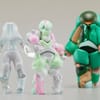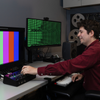Joel Gethin Lewis, interactive creative director of the media art collective “Universal Everything”, recently visited Barcelona to give a talk at OFFF, a 3-day design festival celebrating visual creativity. We met up with Joel at the Disseny Hub in Poblenou to learn more about the studio’s approach to creating joyful and caring art using the latest tools.
You use technology as your “paintbrush” while always focusing on the human connection. How do you achieve that within your practice?
Joel Gethin Lewis: Universal Everything was founded by Matt Pyke in 2004 to find interesting new ways of using technologies to communicate universally. That’s also shown in the early work, which focused on the human figure in motion. And as we all have bodies, this is a great and universal vessel for communication that everyone can relate to.
There’s also a misconception that technology is this digital, intangible or shiny thing. If you think about it, we are surrounded by technology, whether it’s the clothes we wear, the buildings we live in or every other object we touch. Everything we make is by using technology. As a studio, we think deeply about creating communication using the latest tools. That’s why sketching and prototyping are very important to us. Ultimately, we want to make something engaging that as many people as possible can enjoy.
The video installation “Infinity,” by Universal Everything on display at a South Korean subway station since the beginning of 2022, features a continuous loop of lively fantasy commuters strolling past. The focal point of this ever-changing, computer-generated artwork is the motion of the hair that “flops, spikes and frizzles.” The work draws inspiration from the Futurist sculptures of Boccioni from the early 1900s, which sought to represent an abstracted human body in motion.
In another interview, your founder Matt Pyke also explained that he drew inspiration from the fact that humans are very sensitive to motion from an evolutionary standpoint, which is still ingrained in our brains. Can you please elaborate on that?
Joel Gethin Lewis (Universal Everything): Our survival technique as a species links to our ability to sense animal motion. It’s an evolutionary trait that has allowed us to develop a heightened sensitivity over time. It’s also something that artists have intuitively used for centuries. Many art forms that stood the test of time are figurative and often depict animals in motion.
Even if we look at ancient cave paintings, we see a fascination with expressing motion. Recent archaeological work suggests that these drawings, viewed in the flickering light of a fire, would animate when the flame changed direction. So you could say that these were the first animated films in human history.
In Transfiguration, the moving figure portrays a character that undergoes continuous changes, mirroring the turbulence of our emotions. This portrayal of nature and evolution highlights the elements of fire, rock, and water.
What are you currently excited about experimenting with?
Joel Gethin Lewis (Universal Everything): We’re excited about exploring a new area we’re developing called beneficial design. While we will continue to create work that conveys joy and playfulness, we’re also exploring solutions with a more serious tone and aiming to support people.
At Offf Barcelona, I’ll discuss some of our projects in this area, including a collaboration with researcher Samantha Gallivan in London to create an interface for chronic pain patients to visualize their pain more accurately.
The idea is to help them communicate effectively with medical professionals, receive better diagnoses, and reduce their pain. We’re also working on a project that visualizes energy usage to increase awareness and encourage people to make more efficient choices.
What made you focus on this new approach?
Joel Gethin Lewis (Universal Everything): The idea of play and care is really important to us. We drew inspiration from the writer, anthropologist, and political activist David Graeber, who coined the term “bullshit jobs” and strongly advocated for the 99%. Unfortunately, he has since passed away, but he remains an inspiration to me personally when thinking about sustainable activities for humans.
At the Chaos Communication Congress in Germany, he spoke about the concept of play and care as the only sustainable activities available to humans. His point was that if you’re not doing something playful or caring, maybe you shouldn’t do it at all.
The films “Machine Learning” explore the question: Can humans teach machines to move? Universal Everything used research into motion capture to collaborate with dancer and choreographer Dwayne-Antony Simms.
You are also experimenting with the question: What if artworks are not static but constantly evolving?
Joel Gethin Lewis (Universal Everything): We’ve always been curious about creating something dynamic and evolving. It’s fascinating to think about how to take a set of algorithms, ideas, or visual information and code them into something that can transform over time.
It’s exciting to play with these technologies and think about a film that was not just a full stop but a never-ending story. The challenge with something that evolves over time is: what if it goes in a direction you didn’t anticipate? With great power comes great responsibility.
I also think the most intriguing works serve as an allegory for the human experience. We, as humans, are a never-ending story ourselves, constantly evolving. We find this concept fascinating, so we will continue experimenting with it. Additionally, I think that the most interesting art and design also reflect nature in some way simply because there is nothing that isn’t nature.
Can you name an example that you addressed through your work?
Joel Gethin Lewis (Universal Everything): We made a film series called “Nature Always Wins” to remind us of that, but it has more to it than that. When you observe the world, imagining what it might look like in the future is really fascinating. You can see how cities and buildings have grown and changed over time, making you wonder what they’ll look like in another hundred or thousand years. Some places make it obvious – you can see how nature is constantly pushing back against human-made structures.
In the film series, the focus lies on airports as some of the most engineered places in the world. You can see all of the infrastructure and technology put in place to resist nature – after all, you don’t want trees growing in the middle of the runway.
But at the same time, you know that eventually, nature will win and take over again. It’s both comforting and terrifying to think about, and it makes you realize how much of our human activity evolves around resisting nature somehow. We always try to tidy things up and keep everything in its place, but the trees keep growing through the cracks, reminding us that we can’t control everything.
The artwork “Into the Sun” by Universal Everything is interactive and reacts to the movements of the person viewing it. Its title is derived from the Japanese term “komorebi,” which refers to the time of day when sunlight filters through the tree leaves during early morning or late afternoon.
In your practice as a creative director, you focus on interactive art. Why did you choose this particular medium?
Joel Gethin Lewis (Universal Everything): I think interactive art is so fascinating because it takes the idea of art as a conversation to the next level. It’s an entirely new medium. But somehow, all art is interactive when you think about it. It’s like a form of time travel.
I recently went to New York for a holiday and visited the Museum of Modern Art. It’s an insane collection. What’s impressive is that they have a whole section dedicated to Monet’s water lilies. And looking at those paintings was like experiencing a hologram. They’re flat, but they have a depth and a sense of time that’s almost tangible.
You can feel the gestures Monet made over 100 years ago, reaching through time and touching you. That’s what I love about art – it’s a way to connect with people and experiences from the past, present, and can even reach into the future. And with interactive art, we can take that connection and make it even more engaging.
Don’t get me wrong; I’m not saying we’re as good artists as Claude Monet was. However, we use the latest technology in our work because that’s what artists like Monet did. When painting, he used the newest paints and chemicals to create colors in a way that wasn’t even possible before. And today, we have other emerging technologies, we can experiment with to create something entirely new.
How do you approach working with these new technologies?
Joel Gethin Lewis (Universal Everything): We approach it with a beginner’s mindset and in an almost naive way. I think art’s true power lies in its ability to communicate complex ideas in a way that resonates with us on a deep level. That’s why it’s so essential. I mean there is a reason we create art once we have met our basic needs, like food and shelter. Or, to say it in the words of one of my favorite artists, Brian Eno: “Art is everything you don’t have to do.”
It’s also interesting to think about utopias as useful illusions. It would be fantastic if everyone had an art practice with the opportunity to create something meaningful and expressive. That would be incredibly beneficial for society. Ultimately, what is the artistic practice? It’s noticing; it’s really looking because everywhere there is wonder and joy; it’s ridiculous. So our work at Universal Everything is also about fostering that sense of curiosity.
One of your recent works, Maison Autonome, conveys Universal Everything's playfulness. Please tell me more about the process of making it.
Joel Gethin Lewis (Universal Everything): It’s been a lot of fun! We stumbled upon some incredible motion capture data. Unlike the usual data showing a perfect human figure, this one depicted people of all shapes and sizes in motion. The best part is that it’s abstracted, which means it’s universal and has no biases.
You can just enjoy the movement of a beautiful bottom, arm, or any other part without any preconceived notions. The poses are typical but elevated and presented abstractly. We intentionally avoid creating photorealistic depictions of humans because that’s not what we’re interested in. There are plenty of people doing that already. Our goal is to create the most joyful humans.
What else is key to creating art that resonates with a universal audience?
Joel Gethin Lewis (Universal Everything): To create work that resonates universally, you must start by making something that truly speaks to you. If you try to do something that speaks to everyone, it doesn’t work. No one will understand it. And as I said before, having fun with it is essential. Make something that brings a smile to your face.
Nile Rodgers from the band Chic, who has worked with Daft Punk, shared a great insight in an interview recently. When asked how he deals with bad reviews or disappointing chart rankings, he said he realized he couldn’t control what other people think of his work. Instead, he focused on what he could control: creating music. So if someone criticized his album, he could simply respond, “But we had a great time making it.”





